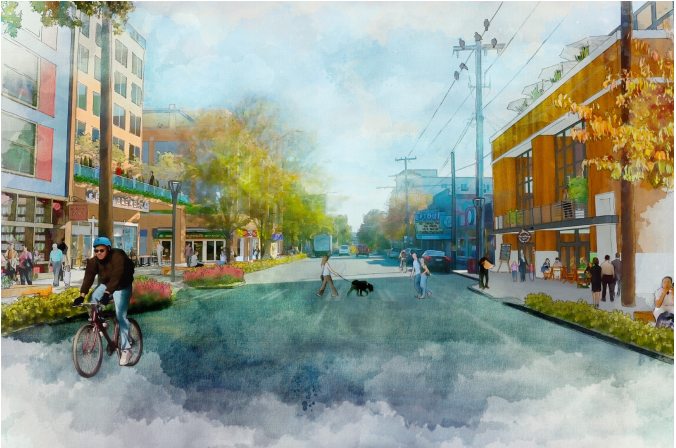On Monday, the Seattle City Council approved a slate of land use changes spanning improvements to the design review process to rezoning large swaths of the Uptown neighborhood. Other changes included putting a temporary moratorium in place for certain uses in the Aurora-Licton Springs Urban Village and adding targeted amendments to the Comprehensive Plan. All of the legislation was unanimously approved (Councilmember Bruce Harrell was absent).
Uptown Zoning and Development Regulation Changes
A significant rezone was adopted for the Uptown neighborhood. The rezone and companion changes to development standards were an outgrowth of a neighborhood-wide urban design framework. Zoning changes were focused on creating a more walkable, livable, and dense Uptown. This is reflected through regulatory requirements built into the new Seattle Mixed-Uptown (SM-UP) zone that was widely applied to the neighborhood.
SM-UP zones have custom regulations for:
- Street-level uses, street-level facade requirements, and enhanced parking standards;
- Maximum and minimum development density;
- Maximum building width, facade modulation, and maximum blank facade standards;
- Incentive zoning for childcare facilities, streetscape improvements, open space, and historic preservation; and
- Podium site coverage and height, tower floorplate maximums, and number of towers allowed.
Some zoning changes will simply get the standard Mandatory Housing Affordability (MHA) bump by modestly increasing building height a story and floor area allowances for existing zones (e.g., Lowrise 3 (LR3) to Lowrise 3 with an M suffix (L3 (M)). But all of the rezones unlock MHA requirements, which differ between residential and commercial development.
Residential developments will be expected to contribute between 7% and 10% of the dwelling units as affordable or pay affordable housing development fees to the City at a rate of $20.75 to $29.75 pre square foot. Likewise, commecial development be expected to contribute 5% to 10% of total floor area as affordable housing or pay affordable housing development fees to the City at a rate of $8.00 to $29.75 per square foot. The rezones are estimated to deliver up to 600 affordable housing units over the next 20 years.
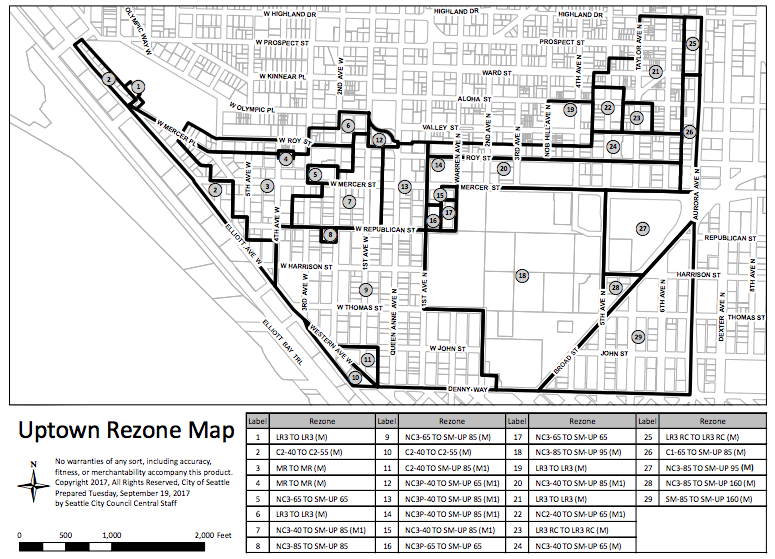
In committee, a variety of amendments were considered but not make the final cut, including:
- Further increasing building heights along the Mercer Street and Roy Street corridors (between the two streets) from 85 feet to 125 feet. This amendment would have further rezoned the KCTS site to 125 feet. Other companion changes to development regulations would have followed to specific floor area ratio maximums, upper-level stepbacks, parking restrictions, and use of incentives.
- Elimination of a special development standard departure for projects in the Uptown neighborhood.
- Adding an extra floor area incentive for on-site development of mandatory affordable housing instead payment of affordable housing fees to the City.
- Reduction of upper-level stepbacks to an average of five feet instead of ten feet for portions of a structure above 45 feet or 65 feet along Roy Street, Queen Anne Ave N, 1st Ave N, and 5th Ave N. The upper-level stepback requirements remained at ten feet feet.
Amendments that were successful in committee, included:
- Further increasing building heights in the “heart of Uptown” from 65 feet to 85 feet (this is reflected in Labels 7, 13, and 15 in the image above as SM-UP 85 (M1)).
- Expanding the amount of extra floor area that can be achieved by providing art space and preserving designated landmark structures.
- Adding an extra floor area incentive for any developments that would include co-development of a public school within SM-UP zones.
- Adding an extra floor area incentive for family-sized units with two or more bedrooms. At least 10 family-sized units would need to be constructed meeting minimum unit size requirement as well as private and common amenity requirements. This is similar to incentives adopted for family-sized units in the University District, South Lake Union, Downtown, and Chinatown-International District.
- Requiring Transportation Managment Programs (TMPs) for all developments that would create 50 or more single-occupant vehicle trips in a PM hour or multifamily residential developments that would create 50 or more vehicle trips in a PM hour or 25 or more vehicles parking on the street overnight. Each TMP would be unique and necessitate a developer to come up with alternatives to driving alone, such as providing more bike parking and subsidized transit passes to future tenants.
- Establishing a parking maximum for office uses at no more than one parking spaces for every 1,000 square feet of gross floor area in office use.
Additionally, a companion resolution was adopted designating the Uptown as the “Uptown Arts & Cultural District,” directing Office of Arts and Culture to work with the neighborhood to support and advance the arts and artists, and encouraging the local community to promote and sustain the arts.
Design Review Improvements
The City Council adopted a very different set of improvements to the design review program from what was originally envisioned and transmitted by the Seattle Department of Construction Inspection (SDCI). Some big ideas still won out in the end, such as:
- New requirements for early community outreach;
- Reforming the approach to setting thresholds for design review;
- Adding site characteristics as a element in determining the type of design review process required;
- Expanding design review to include more development types and zones;
- Revising the composition of design review boards and encouraging the participation of youth on them through the Get Engaged program; and
- Limiting the number of design review meetings for projects.
In committee, the base legislation was heavily revised. Changes included:
- Further delaying the effective date of the design review changes to July 1, 2018 instead of 60 days from adoption.
- Allowing an additional 0.5 floor area ratio or 10 feet in building height for protection and retention of an exceptional tree as part of development standard departures.
- Giving more authority over design review to special review and landmark preservation distric boards. Under existing code, departures from development standards must go to a design review board, but the new option would consolidate that authority to the governing special review or landmarks preservation distric board eliminating the need to go to two bodies for review.
- Streamlining the design review process for projects outside of Downtown and industrial zones that would ordinarily go through full design review to instead be processed through administrative design review if the applicant elects to construct mandatory affordable housing on-site. Additionally, projects providing mandatory affordable housing on-site would be eligible for an absolute maximum number of design review meetings where meetings caps otherwise would not apply.
- Revising thesholds for design review and eliminating Hybrid Design Review in favor of Administrative Design Review and Streamlined Design Review.
- A slate of other very technical amendments were made largely adding more specificity and clarification.
Much of the discussion on amendments in committee focused on adjusting design review thresholds and whether to keep or eliminate Hybrid Design Review from the proposal. Public opinion was highly mixed on Hybrid Design Review which would require an applicant to have a project reviewed by both administrative SDCI planning staff and local design review board in a two-step process. The idea behind the process to was to blend Administrative Design Review and Full Design Review processes together in theory making the process quicker but still having direct public participation.
Early in the summer, SDCI had envisioned Hybrid Design Review as a full fledge element of the design review program. But comments on a draft proposal swayed the department into limiting it as a trial pilot program by the time legislation was introduced to the City Council. Ultimately, the Planning, Land Use, and Zoning (PLUZ) Committee decided to eliminate the Hybrid Design Review process in favor Administrative Design Review and Streamlined Design Review, which are both existing processes.
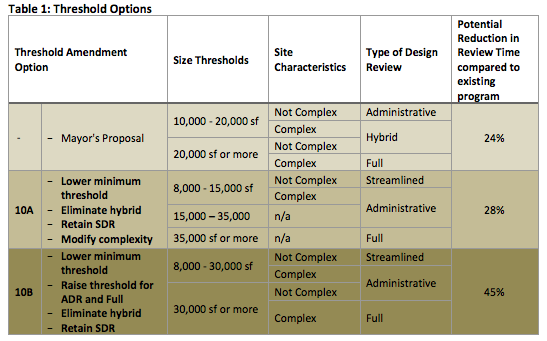
Standing by the objective to improve the design review program, the PLUZ Committee considered two alternative approaches to using Administrative Design Review and Streamlined Design Review instead of Hybrid Design Review. The difference boiled down to size thresholds, as shown as Options 10A and 10B above. Option 10B was the more aggressive option in terms of reducing design review timeframes. The PLUZ Committee, however, settled on Option 10A which was still projected to modestly save time through design review over the SDCI proposal.
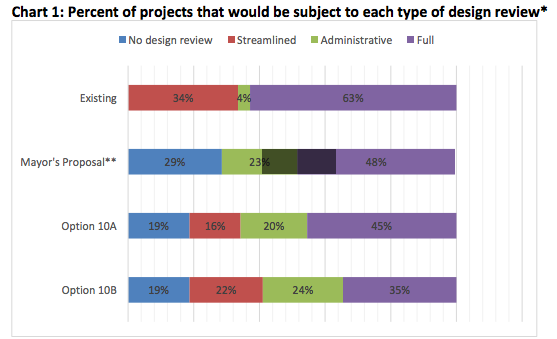
Administrative Design Review and Streamlined Design Review are still required to include early community outreach as part of the review process. The changes would overhaul how Administrative Design Review and Streamlined Design Review would also otherwise work. Streamlined Design Review would not just be limited to townhouse and rowhouse developments anymore.
The new thresholds would be as follows:
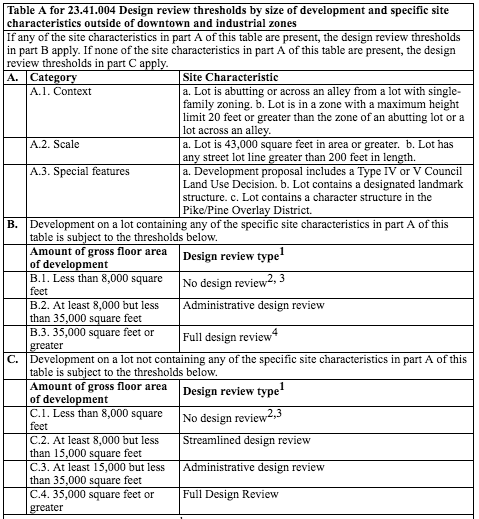

One thing to note about the thresholds is that there are certain exceptions that apply. Lower thresholds could trigger design review if a project is proposed on or before December 31, 2023 as follows:
- Any development that is 5,000 to 8,000 square feet and located on a property that was rezoned from single-family residential to Lowrise 1 (LR1) or Lowrise 2 (LR2) zones (this is represented as Footnote 2 in the table above); or
- Any development that is 5,000 to 8,000 square feet and located on a property that was rezoned from single-family residential to Lowrise 3 (LR3), Midrise (MR), Highrise (HR), or any Commercial (C) or Neighborhood Commercial (NC) zone (this is represented as Footnote 3 in the table above).
The bulk of the design review changes will come into force mid-next year. SDCI will adopt administrative changes to help implement the new design review program, including the adoption of future rules and developing the early outreach program.
Pedestrianizing Aurora-Licton Springs
Last month, Councilmember Debora Juarez sponsored a temporary moratorium on new heavy commercial, manufacturing, and warehouse uses in the Aurora-Licton Springs Urban Village. Councilmember Juarez proposed the moratorium as a means to reserve development capacity within the neighborhood for more intensive mixed and pedestrian-oriented uses until proposed rezones envisioned for the urban village could be adopted.

The MHA program has identified a variety of possible rezones for the Aurora-Licton Springs Urban Village, including rezones of all Commercial 1 (C1) and Commercial 2 (C2) zones to Neighborhood Commercial 2 (NC2) and Neighborhood Commercial 3 (NC3) zones. This would effectively reflect the same prohibition on heavy commercial, manufacturing, and warehouse uses that the moratorium contains. Some of the NC2 and NC3 zones could receive Pedestrian zone designations, which are paired with minimum density, active ground floor use, and building transparency requirements as well as restrictions on parking. NC2 and NC3 also generally have higher design requirements over their C1 and C2 counterparts. The proposed rezones could help realize a more pedestrian-oriented residential and commercial district, something that many in the area have been advocating for quite some time.
Before a final vote on the legislation, Councilmember Juarez emphasized the importance of the legislation and expressed gratitude to community members for bringing the issue to her attention. She reiterated that the moratorium will not force any existing businesses to move and that vested development applications would continue to move forward. Councilmember Juarez also remarked that the moratorium would help realize overarching goals of creating a denser, more walkable residential and commercial district.
The moratorium will remain in effect for up to one full year. The MHA rezones are anticipated to be in force in August 2018 according to a work plan for permanent land use controls.
2016-2017 Comprehensive Plan Amendments
A final set of amendments to the Comprehensive Plan were adopted as part of the City’s annual review. The changes are considered to be minor in nature. Three sets of amendments were made to the Comprehensive Plan, including:
- Referencing the “Parks Development Plan” as the “Parks and Open Space Plan”—the name was changed this year when the 2017 Parks and Open Space Plan was adopted;
- Adding a new environmental justice Land Use Policy that would require consideration of air pollution impacts on residential populations; and
- Revising and adding new cultural and economic vitality policies to the Chinatown/International District Neighborhood Plan.
The cultural and economic vitality policies for Chinatown-International District direct the City to develop anti-displacement and affordability strategies for commercial businesses, cultural identity strategies for Little Saigon, and expand access to community facilities like libraries and other public amenities.
Councilmember Johnson mentioned that a proposal to rezone and redesignate a Beacon Hill property on the Future Land Use Map had been considered as part of the annual minor update process. The rezone and resignation would have allowed the 2.6-acre site to be redeveloped with multifamily residential uses. However, Councilmember Johnson said that the site was too small and could have set an unwanted prescedent for similar requests in the future if adopted.
Stephen is a professional urban planner in Puget Sound with a passion for sustainable, livable, and diverse cities. He is especially interested in how policies, regulations, and programs can promote positive outcomes for communities. With stints in great cities like Bellingham and Cork, Stephen currently lives in Seattle. He primarily covers land use and transportation issues and has been with The Urbanist since 2014.

